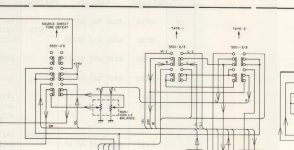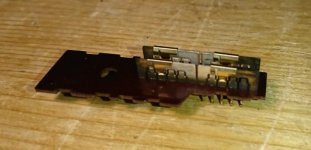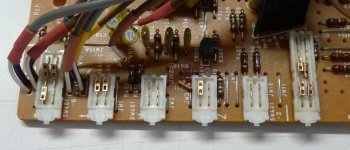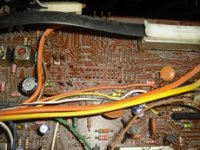I have a Marantz PM44SE integrated amp which I’m still pretty happy with. It has served me well for many years but has developed an intermittent, though annoying, fault.
The problem is severe distortion on the left channel (both sets of speaker connectors and headphone jack) which comes and goes but tends to rear its head at some point during any listening session.
The fault seems to be related to the input selector and involves all inputs including phono. When the fault occurs, rotating the selector knob slightly usually rectifies the situation for a time. Opening the cover reveals that the input selector knob is not attached to a rotary switch but instead uses a mechanical cable linkage to a slide switch mounted on an input board separate to the main PCB (probably to keep the signal path short). I think it’s fair to assume that the fault is due to either wear or dirt in this assembly as it appears that the audio signal is routed through the multi-way switch rather than using electronic switching.
Does anyone have any experience of opening one of these switches up? If not then I’ll have a go at it. At worst I can hardwire the board to a single pair of input sockets and use an external switcher, though I’d like to preserve the phono stage if possible.
Any advice would be appreciated.
The problem is severe distortion on the left channel (both sets of speaker connectors and headphone jack) which comes and goes but tends to rear its head at some point during any listening session.
The fault seems to be related to the input selector and involves all inputs including phono. When the fault occurs, rotating the selector knob slightly usually rectifies the situation for a time. Opening the cover reveals that the input selector knob is not attached to a rotary switch but instead uses a mechanical cable linkage to a slide switch mounted on an input board separate to the main PCB (probably to keep the signal path short). I think it’s fair to assume that the fault is due to either wear or dirt in this assembly as it appears that the audio signal is routed through the multi-way switch rather than using electronic switching.
Does anyone have any experience of opening one of these switches up? If not then I’ll have a go at it. At worst I can hardwire the board to a single pair of input sockets and use an external switcher, though I’d like to preserve the phono stage if possible.
Any advice would be appreciated.
I have a Marantz PM44SE integrated amp which I’m still pretty happy with. It has served me well for many years but has developed an intermittent, though annoying, fault.
The problem is severe distortion on the left channel (both sets of speaker connectors and headphone jack) which comes and goes but tends to rear its head at some point during any listening session.
The fault seems to be related to the input selector and involves all inputs including phono. When the fault occurs, rotating the selector knob slightly usually rectifies the situation for a time. Opening the cover reveals that the input selector knob is not attached to a rotary switch but instead uses a mechanical cable linkage to a slide switch mounted on an input board separate to the main PCB (probably to keep the signal path short). I think it’s fair to assume that the fault is due to either wear or dirt in this assembly as it appears that the audio signal is routed through the multi-way switch rather than using electronic switching.
Does anyone have any experience of opening one of these switches up? If not then I’ll have a go at it. At worst I can hardwire the board to a single pair of input sockets and use an external switcher, though I’d like to preserve the phono stage if possible.
Any advice would be appreciated.
Since it happens on any input it is very unlikely it is the input selector - you would need to have a problem on each setting that is exactly the same to all the others.
More probable is an input coupling cap that slowly leaks and develops an offset after some time, which unbalances the amp circuitry downstream. Moving the input selector can discharge the switch through another input which solves it for some time.
I would look at coupling caps.
jd
Thanks Janneman. I will certainly bear this in mind.
My instinct, however, is that the problem is switch-related. I probably didn't describe the problem in enough detail.
The fault can occur at any time: on power-up; after seconds, minutes, hours, or not at all. Also, it is not necessary to move the input switch to another input to make the problem go away. Just "wiggling" it very slightly will do the trick. In fact, when the signal is clean, it is possible to induce the distortion by the same wiggling action. There is also an accompanying crackle which really does feel like dirty contacts. What if the moving "wiper" component of the switch were contaminated/worn, would this not manifest itself across all inputs?
My instinct, however, is that the problem is switch-related. I probably didn't describe the problem in enough detail.
The fault can occur at any time: on power-up; after seconds, minutes, hours, or not at all. Also, it is not necessary to move the input switch to another input to make the problem go away. Just "wiggling" it very slightly will do the trick. In fact, when the signal is clean, it is possible to induce the distortion by the same wiggling action. There is also an accompanying crackle which really does feel like dirty contacts. What if the moving "wiper" component of the switch were contaminated/worn, would this not manifest itself across all inputs?
That's quite plausible: without having the schematic under the eyes, it is difficult to guess exactly what (intricate) path the signal follows.Thanks Janneman. I will certainly bear this in mind.
My instinct, however, is that the problem is switch-related. I probably didn't describe the problem in enough detail.
The fault can occur at any time: on power-up; after seconds, minutes, hours, or not at all. Also, it is not necessary to move the input switch to another input to make the problem go away. Just "wiggling" it very slightly will do the trick. In fact, when the signal is clean, it is possible to induce the distortion by the same wiggling action. There is also an accompanying crackle which really does feel like dirty contacts. What if the moving "wiper" component of the switch were contaminated/worn, would this not manifest itself across all inputs?
Dismantling such a switch is always a delicate and risky business.
You could try a contact cleaning fluid, but not the kind that leaves an oily residue, like Kontakt 60 or similar: something that evaporates completely.
Isopropanol is also a possibility.
Operate the switch back and forth while the fluid is drying.
I have also found a trick that might be useful in a case like yours: connect a high current/low voltage DC source across each contact in turn, and manoeuver the switch a number of times for each contact. The short circuit current will burn the oxide layer and restore a better contact; can be combined with the fluid.
The best source for this purpose is a lab PSU adjusted at 5A, 0.8V or thereabout. At this voltage there is no risk a semiconductor junction conducts too heavily.
Alternatively, a single rechargeable element of 1.2V might do, but there is a non-zero risk of destroying something.
Some switch cleaner ( Contact Cleaner : Electronics Cleaners : Maplin ) sprayed, sparingly into the switch will cure this problem.
Once cured, a movement of all the potentiometers and switches, once a month, with the set off will keep the oxidised contacts to a minimum.
🙂
Once cured, a movement of all the potentiometers and switches, once a month, with the set off will keep the oxidised contacts to a minimum.
🙂
Thanks Janneman. I will certainly bear this in mind.
My instinct, however, is that the problem is switch-related. I probably didn't describe the problem in enough detail.
The fault can occur at any time: on power-up; after seconds, minutes, hours, or not at all. Also, it is not necessary to move the input switch to another input to make the problem go away. Just "wiggling" it very slightly will do the trick. In fact, when the signal is clean, it is possible to induce the distortion by the same wiggling action. There is also an accompanying crackle which really does feel like dirty contacts. What if the moving "wiper" component of the switch were contaminated/worn, would this not manifest itself across all inputs?
Those Marantz amps (PM66 / PM44) etc. are notoriously bad for dry joints.
I would check for dry joints around the selector switch in particular, but you'll probably find them all over the board.
Tony.
Last edited:
Thanks everybody.
I think I'll dp a quick clean of the switch (if I can get the fluid in there). If I have to dismantle I'll take out the input PCB and check the soldering. I did have to resolder a few pads on the volume PCB a couple of years ago. Dry/loose joints on the cable multi-connector and a lot of dull, crystalline looking solder.
I think I'll dp a quick clean of the switch (if I can get the fluid in there). If I have to dismantle I'll take out the input PCB and check the soldering. I did have to resolder a few pads on the volume PCB a couple of years ago. Dry/loose joints on the cable multi-connector and a lot of dull, crystalline looking solder.
Thanks everybody.
I think I'll dp a quick clean of the switch (if I can get the fluid in there). If I have to dismantle I'll take out the input PCB and check the soldering. I did have to resolder a few pads on the volume PCB a couple of years ago. Dry/loose joints on the cable multi-connector and a lot of dull, crystalline looking solder.
Servisol aerosol contact cleaner (available at Maplin amongst others) is ideal for cleaning switches. In desperate situations I have even used WD40 but it tends to smell a bit!
Tony.
Well, last night I decided to bite the bullet and have a go at the repair.
Removed the input and phono boards, pulled off the clip-on mechanical actuator and desoldered the switch (original soldering looked pretty good in comparison to some in this amp). Bending open the tabs and removing the cover made the source of the fault immediately obvious. The silver(?)-plated contacts were buried under a thick sheet of oxidation and grime.
I used methylene chloride (dichloromethane), to remove most of this, finishing the job with a sliver cut from an abrasive rubber PCB polishing block. I like methylene chloride (bought from a model shop as an ABS plastic welding solvent), it is very similar to the old trichloroethylene and IMO much better than Isopropanol. It is, however, very volatile and evaporates rapidly - great for spot cooling though. Just be careful near plastics - fibreglass and phenolic boards/switch bases are OK.
After a bit of a fiddle with the fragile looking brass wipers, the switch was re-assembled with a few spots of 5-minute epoxy replacing the original securing tags. PCBs were checked for crappy joints and all bolted back together.
The amp now sounds as good as ever despite being dropped 2 feet onto a hard floor while attempting to blindly reconnect speaker leads which were a bit short in a space which was a bit tight on a shelf which was a bit narrow.
All-in-all a worthwhile exercise. Thank you to all those who offered advice.
Removed the input and phono boards, pulled off the clip-on mechanical actuator and desoldered the switch (original soldering looked pretty good in comparison to some in this amp). Bending open the tabs and removing the cover made the source of the fault immediately obvious. The silver(?)-plated contacts were buried under a thick sheet of oxidation and grime.
I used methylene chloride (dichloromethane), to remove most of this, finishing the job with a sliver cut from an abrasive rubber PCB polishing block. I like methylene chloride (bought from a model shop as an ABS plastic welding solvent), it is very similar to the old trichloroethylene and IMO much better than Isopropanol. It is, however, very volatile and evaporates rapidly - great for spot cooling though. Just be careful near plastics - fibreglass and phenolic boards/switch bases are OK.
After a bit of a fiddle with the fragile looking brass wipers, the switch was re-assembled with a few spots of 5-minute epoxy replacing the original securing tags. PCBs were checked for crappy joints and all bolted back together.
The amp now sounds as good as ever despite being dropped 2 feet onto a hard floor while attempting to blindly reconnect speaker leads which were a bit short in a space which was a bit tight on a shelf which was a bit narrow.
All-in-all a worthwhile exercise. Thank you to all those who offered advice.
Hello!! I have this problem too with this kind of switch. In my case all inputs works fine but one, in one channel. Moving in and out of that input solves the problem for some time.
I am afraid to desolder the switch.
Can I apply the spray without desoldering it? How do you pull out the mechanical actuator? Thanks for your help!
I am afraid to desolder the switch.
Can I apply the spray without desoldering it? How do you pull out the mechanical actuator? Thanks for your help!
It seems a little risky task.
To make the risk justified you should measure the contact resistance of the switches in the closed position (can be measured in circuit). It should display a stable reading of whatever your multimeter shows for short circuited leads but I have also seen values from 5 to 70 ohms...
Is that measure in ohms normal, as long as its stable?
No, the figures I wrote above are abnormal.
After cleaning the contacts my multimeter typically shows ca 0,2...0,3 ohm but that is the reading also when I connect the clips of the measuring leads (i.e. loopback resistance).
The easy was is just to spray some Deoxit into the switch and work it back and forth numerous times, then spray and repeat.
No need to disassemble anything.
But remove the power cord, first.
No need to disassemble anything.
But remove the power cord, first.
The easy was is just to spray some Deoxit
Yes, this is definitely the easy way and probably standard way in any audio repair shop. I would not imagine there are too many customers willing to pay for the technician's time needed for fully cleaning the switch 😉
The thing is that the switch is all closed!
Usually the metal-cased switches like these can be prised open from the bottom:
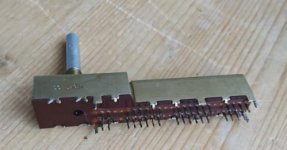
- after unsoldering them...
- Home
- Amplifiers
- Solid State
- Marantz PM44SE - Distortion from input selector
